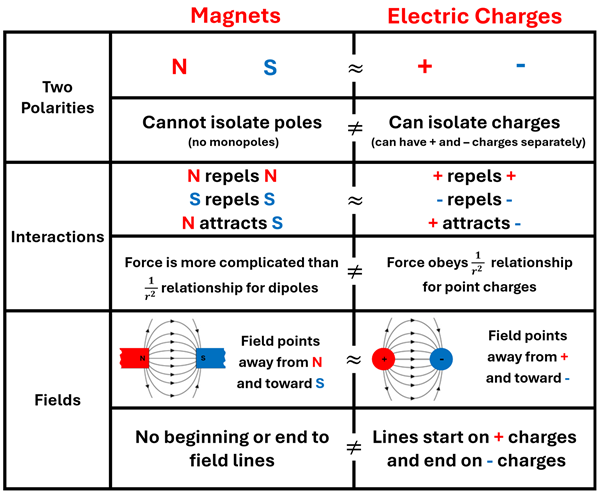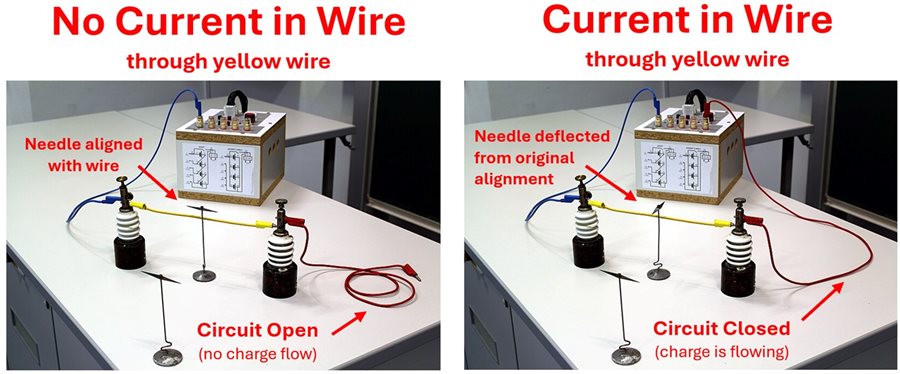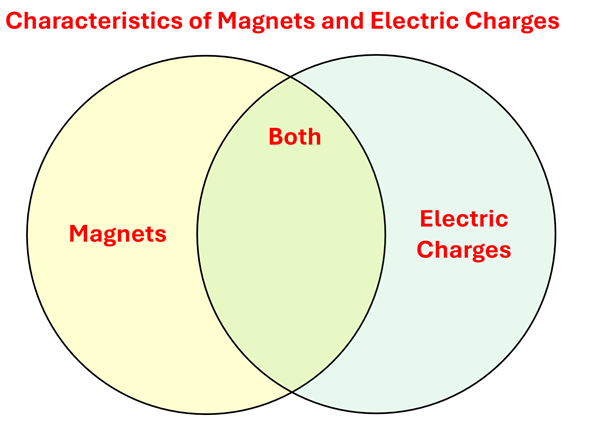Hold down the T key for 3 seconds to activate the audio accessibility mode, at which point you can click the K key to pause and resume audio. Useful for the Check Your Understanding and See Answers.
Similarities and Difference Between Magnets and Electric Charges
Earlier in this lesson, we uncovered many similarities that exist between magnets and electric charges. Take for example that magnets have two poles—north and south. Similarly, there are two types of electric charge. Next, consider how like poles of magnet repel each other and opposites attract. We saw this same rule of repulsion and attraction with charges. In addition, we know that both magnets and charges produce fields. In fact, both produce fields that have striking similarities.
There are differences, however. We can, for example, have find in a nature isolated positive charge and negative charges. Magnets, on the other hand, are always dipoles. They have a north and south pole that cannot be separated even if we cut the magnet in half. This leads to another difference. Electric field lines start on plus charges and end on minus charges. Plus charges are sometimes called ‘sources’ of electric field lines whereas minus charges are ‘sinks.’ But magnetic field lines have no start or end—they are continuous loops. There is no such thing as a ‘source’ or ‘sink’ of magnetic field lines. And yet another difference comes in exploring how the force between charges and how the force between magnets varies with distance. The electric force between two point charges can be determined using Coulomb’s Law. This inverse-squared dependence on distance becomes more complicated with magnets. Dipoles actually exhibit something more like an inverse-cubic relationship with distance.

The diagram above shows similarities and difference between Magnets and Electric Charges.
Both Magnets and Charges have Two Polarities (North and South for magnets, Positive and Negative for Particles). However, Magnets you cannot isolate the poles (no monopoles), where as Electric charges you can isolate the charges (can have positive and negative charges separately).
As for interactions, both have similar repel and attract rules. North to North and Positive to Positive repels. South to South and Negative to Negative repels. North to South and Positive to Negative Attract. However, Magnetic forces are more complicated than the one over r squared relationship for dipoles, whereas Electric Charges obey the one over r squared relationship for point charges.
For Fields, both Magnets and Electric Charges have fields that point away from the North or Positive areas, and point towards the South or Negative areas. However, Magnetic forces do not have a beginning nor end to field lines, whereas Electric field lines start on the positive charge and end on the negative charge.
Searching for Connections Between Electricity and Magnetism
Until the early 1800’s, electricity and magnetism were thought to be two separate phenomena. In 1820, however, a remarkable discovery was made. During his physics lecture, Hans Christian Oersted discovered that a compass needle was deflected when a switch was closed allowing current to pass through a nearby wire. The movement of a compass needle suggested a magnetic field was created by this electric current. Oersted was credited with the discovery that
Electricity causes magnetism.
In other words, the source of all magnetism is from moving electric charges.

Figure 1
This discovery not only earned Oersted a place in history, but it also revolutionized our understanding of magnetism. From that day forward a whole new world of technological advancements would be made. Electric motors, speakers, power plants, and wireless communication are just the start of innovations that came as a result of Oersted’s simple observation. The field of electromagnetism was born. Understanding the physics behind these inventions is where we will go next as uncovering electromagnetism is our goal in Lesson 2.
Check Your Understanding
Use the following questions to assess your understanding. Tap the Check Answer buttons when ready.
1. Create a Venn Diagram similar to the one shown below. Decide if each characteristic is true for magnets, electric charges, or both. Place the letter for that characteristic in the appropriate region of your diagram.

A: Produces a Field
B: Field lines form continuous loops
C: Field lines have 'sources' and 'sinks'
D: Opposites attract, likes repel
E: Two poles/types exist
F: The poles/types can be isolated
G: The poles/types cannot be isolated
H: Can exist only as a dipole
I: Obeys Coulomb's Law
2. Oersted discovered that electricity causes magnetism. What observation did he make that served as evidence for this statement?

Figure 1 Source: https://commons.wikimedia.org/wiki/File:Oersted-switched-off.jpg and https://commons.wikimedia.org/wiki/File:Oersted-switched-on.jpg